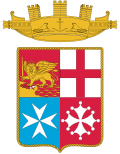 San Marco | |
| Class overview | |
|---|---|
| Name | San Giorgio class |
| Builders | |
| Operators | |
| Preceded by | Soldati class |
| Succeeded by | Impetuoso class |
| Subclasses | Capitani Romani class |
| Built | 1939–1941 |
| In commission | 1955–1980 |
| Planned | 2 |
| Completed | 2 |
| Retired | 2 |
| General characteristics | |
| Type | Destroyer |
| Displacement | |
| Length | 142.2 m (466 ft 6 in) |
| Beam | 14.4 m (47 ft 3 in) |
| Draft | 5.1 m (16 ft 9 in) |
| Propulsion |
|
| Speed | 39 knots (72 km/h; 45 mph) |
| Range | 4,060 nmi (7,520 km; 4,670 mi) at 16 kn (30 km/h; 18 mph) |
| Complement | 314 |
| Sensors & processing systems |
|
| Armament |
|
The San Giorgio class was a class of two destroyers of the Italian Navy. They entered service in 1955, with the last one being decommissioned in 1980. Formerly Capitani Romani-class cruisers of the Regia Marina (Royal Italian Navy) during World War II, they were rebuilt as destroyers during the Cold War. San Giorgio (ex Pompeo Magno) was the first to enter service in 1955 and was modified again from 1963 to 1965 to become a training ship until 1980. San Marco (ex Giulio Germanico) was scuttled by the Germans after the incomplete ship fell into German hands following the Italian Armistice. Following the war, the vessel was raised, rebuilt and renamed and entered service in 1956. San Marco served until 1971.




